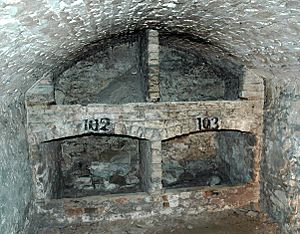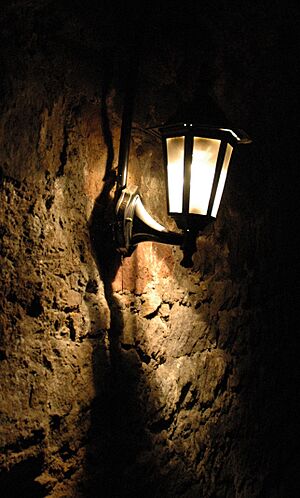Edinburgh Vaults facts for kids
The Edinburgh Vaults, also called the South Bridge Vaults, are a series of underground rooms. They are found beneath the South Bridge in Edinburgh, Scotland. This bridge was finished in 1788. For about 30 years, these vaults were used by businesses. They housed taverns, workshops for shoemakers, and storage areas for merchants.
Over time, the vaults became very damp and had bad air. Because of this, businesses started to leave around the 1820s. Then, some of Edinburgh's poorest people moved in. However, by about 1860, it's thought that even they had left. People only discovered that families had lived there in 1985. During an excavation, workers found old toys, medicine bottles, plates, and other signs of people living there.
Contents
Exploring the Edinburgh Vaults
Edinburgh was growing quickly in the late 1700s. Two bridges were built to help the city expand. These were the North Bridge and the South Bridge. Locals often called them 'The Bridges'. The South Bridge was planned in 1775. It was meant to cross the Cowgate gorge. This gorge was between High Street and the growing University of Edinburgh. Work on the bridge began in August 1785.
Edinburgh's South Bridge was more than just a way to cross from the Old Town to the Southside. It was Edinburgh's first street built especially for shopping. So, builders used as much space as possible. The bridge itself is a long structure with nineteen arches. Today, only one arch is visible. This is the 'Cowgate arch'. The other eighteen arches were hidden behind buildings. These buildings were put up to make the area a busy shopping district. The hidden arches were then given extra floors. This allowed them to be used for different businesses. In total, there are about 120 rooms or 'vaults' under the South Bridge. Their sizes range from two square metres to forty square metres. The South Bridge officially opened for business on March 1, 1788.
Life in the Vaults Over Time
The vault rooms were used for storage and workshops. They worked as planned for only a short time. The bridge had been built very quickly. Its surface was never properly sealed against water. Because of this, the vaults began to flood. Businesses started leaving the vaults as early as 1795.
As businesses left, new people began to use the empty rooms. The Industrial Revolution was changing Britain. The Cowgate area became a very poor part of Edinburgh. The vaults also became extra housing for the city's poor. Living conditions were very difficult. The rooms were small, dark, and wet. There was no sunlight and the air did not move well. There was no running water and no proper sanitation. Many rooms held families of more than ten people. The vaults became a place where many problems occurred.
It is not known exactly when the vaults were closed down. Some people think it was around 1835. Others believe it was as late as 1875. There are almost no written records about the vaults during the time people lived there. All we know is that at some point, tons of rubble were dumped into the vaults. This made them impossible to enter.
The vaults were rediscovered by Norrie Rowan in the 1980s. He was a former Scottish rugby player. He found a tunnel that led to them. From this tunnel, he helped a Romanian rugby player, Cristian Raducanu, escape. Raducanu was seeking political safety weeks before the Romanian Revolution of 1989.
Norrie Rowan and his son Norman Rowan dug out the vaults in the 1990s. They removed hundreds of tons of rubble by hand. They found many interesting things. These included thousands of oyster shells. Oysters were a common food for working-class people in Edinburgh back then.
What Happens in the Vaults Today?
The vaults on the North side of the Cowgate arch are a series of tunnels and rooms. They are mostly used for ghost tours today. The vaults on the South side of the Cowgate arch are a place called The Caves and The Rowantree. This venue hosts private events, weddings, and live music. It also has occasional club nights.
Some areas within The Caves are parts of old buildings. These were once part of Adam Square. They were taken down to build the South Bridge. Original floor tiles, a hearth stone, and parts of a fireplace were found. These were in one of the rooms in The Caves during its excavation. In another room within The Caves, a well was discovered.
During the Edinburgh Festival Fringe in August, The Caves and The Rowantree are very busy. Several other unused vaults are also opened. They become a major festival venue. They host over 60 different shows every day.
Spooky Stories and TV Shows
The television show Ghost Adventures explored the vaults. They said they had many encounters with spirits there.
In 2003, the TV show Most Haunted also investigated the vaults. They also claimed spirits were present. This was in Season 3, Episode 3.
In 2009, a BBC TV team was filming a special show. It featured Joe Swash. They recorded strange voices in the vaults. This happened during an overnight stay by Swash. Swash was the only person in the vaults. He did not hear the voices himself at the time. But the sounds were clear on his microphone. The voices continued for about 20 minutes on the recording. They stopped suddenly after what sounded like children yelling.
BBC sound engineers first thought the sounds might be from nearby nightclubs. But they found this was not correct. No clear explanation could be found. It's possible they were weak radio signals picked up by the microphones. The recordings were shown in the program Joe Swash Believes in Ghosts. It aired on BBC Three in January 2010.
As of 2015, most of the whole area is now closed to the public. Access is carefully watched.
See also
 In Spanish: Bóvedas de Edimburgo para niños
In Spanish: Bóvedas de Edimburgo para niños



